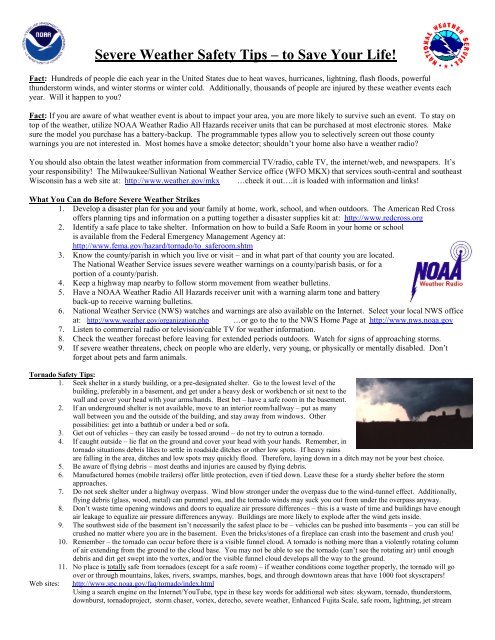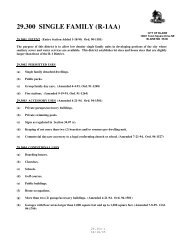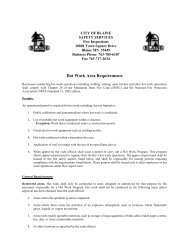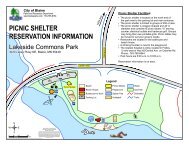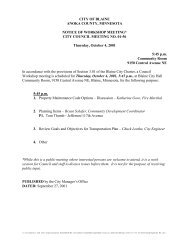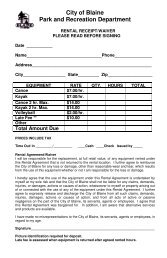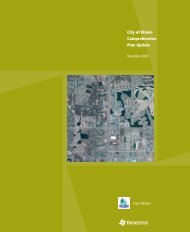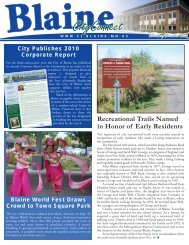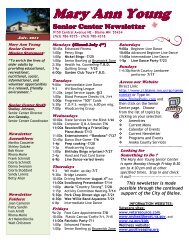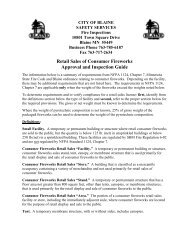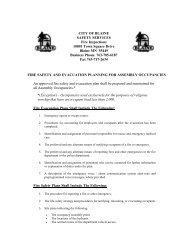Severe Weather Safety Tips To Save Your Life - NOAA
Severe Weather Safety Tips To Save Your Life - NOAA
Severe Weather Safety Tips To Save Your Life - NOAA
You also want an ePaper? Increase the reach of your titles
YUMPU automatically turns print PDFs into web optimized ePapers that Google loves.
<strong>Severe</strong> <strong>Weather</strong> <strong>Safety</strong> <strong>Tips</strong> – to <strong>Save</strong> <strong>Your</strong> <strong>Life</strong>!Fact: Hundreds of people die each year in the United States due to heat waves, hurricanes, lightning, flash floods, powerfulthunderstorm winds, and winter storms or winter cold. Additionally, thousands of people are injured by these weather events eachyear. Will it happen to you?Fact: If you are aware of what weather event is about to impact your area, you are more likely to survive such an event. <strong>To</strong> stay ontop of the weather, utilize <strong>NOAA</strong> <strong>Weather</strong> Radio All Hazards receiver units that can be purchased at most electronic stores. Makesure the model you purchase has a battery-backup. The programmable types allow you to selectively screen out those countywarnings you are not interested in. Most homes have a smoke detector; shouldn’t your home also have a weather radio?You should also obtain the latest weather information from commercial TV/radio, cable TV, the internet/web, and newspapers. It’syour responsibility! The Milwaukee/Sullivan National <strong>Weather</strong> Service office (WFO MKX) that services south-central and southeastWisconsin has a web site at: http://www.weather.gov/mkx …check it out….it is loaded with information and links!What You Can do Before <strong>Severe</strong> <strong>Weather</strong> Strikes1. Develop a disaster plan for you and your family at home, work, school, and when outdoors. The American Red Crossoffers planning tips and information on a putting together a disaster supplies kit at: http://www.redcross.org2. Identify a safe place to take shelter. Information on how to build a Safe Room in your home or schoolis available from the Federal Emergency Management Agency at:http://www.fema.gov/hazard/tornado/to_saferoom.shtm3. Know the county/parish in which you live or visit – and in what part of that county you are located.The National <strong>Weather</strong> Service issues severe weather warnings on a county/parish basis, or for aportion of a county/parish.4. Keep a highway map nearby to follow storm movement from weather bulletins.5. Have a <strong>NOAA</strong> <strong>Weather</strong> Radio All Hazards receiver unit with a warning alarm tone and batteryback-up to receive warning bulletins.6. National <strong>Weather</strong> Service (NWS) watches and warnings are also available on the Internet. Select your local NWS officeat: http://www.weather.gov/organization.php …or go to the to the NWS Home Page at http://www.nws.noaa.gov7. Listen to commercial radio or television/cable TV for weather information.8. Check the weather forecast before leaving for extended periods outdoors. Watch for signs of approaching storms.9. If severe weather threatens, check on people who are elderly, very young, or physically or mentally disabled. Don’tforget about pets and farm animals.<strong>To</strong>rnado <strong>Safety</strong> <strong>Tips</strong>:1. Seek shelter in a sturdy building, or a pre-designated shelter. Go to the lowest level of thebuilding, preferably in a basement, and get under a heavy desk or workbench or sit next to thewall and cover your head with your arms/hands. Best bet – have a safe room in the basement.2. If an underground shelter is not available, move to an interior room/hallway – put as manywall between you and the outside of the building, and stay away from windows. Otherpossibilities: get into a bathtub or under a bed or sofa.3. Get out of vehicles – they can easily be tossed around – do not try to outrun a tornado.4. If caught outside – lie flat on the ground and cover your head with your hands. Remember, intornado situations debris likes to settle in roadside ditches or other low spots. If heavy rainsare falling in the area, ditches and low spots may quickly flood. Therefore, laying down in a ditch may not be your best choice.5. Be aware of flying debris – most deaths and injuries are caused by flying debris.6. Manufactured homes (mobile trailers) offer little protection, even if tied down. Leave these for a sturdy shelter before the stormapproaches.7. Do not seek shelter under a highway overpass. Wind blow stronger under the overpass due to the wind-tunnel effect. Additionally,flying debris (glass, wood, metal) can pummel you, and the tornado winds may suck you out from under the overpass anyway.8. Don’t waste time opening windows and doors to equalize air pressure differences – this is a waste of time and buildings have enoughair leakage to equalize air pressure differences anyway. Buildings are more likely to explode after the wind gets inside.9. The southwest side of the basement isn’t necessarily the safest place to be – vehicles can be pushed into basements – you can still becrushed no matter where you are in the basement. Even the bricks/stones of a fireplace can crash into the basement and crush you!10. Remember – the tornado can occur before there is a visible funnel cloud. A tornado is nothing more than a violently rotating columnof air extending from the ground to the cloud base. You may not be able to see the tornado (can’t see the rotating air) until enoughdebris and dirt get swept into the vortex, and/or the visible funnel cloud develops all the way to the ground.11. No place is totally safe from tornadoes (except for a safe room) – if weather conditions come together properly, the tornado will goover or through mountains, lakes, rivers, swamps, marshes, bogs, and through downtown areas that have 1000 foot skyscrapers!Web sites: http://www.spc.noaa.gov/faq/tornado/index.htmlUsing a search engine on the Internet/YouTube, type in these key words for additional web sites: skywarn, tornado, thunderstorm,downburst, tornadoproject, storm chaser, vortex, derecho, severe weather, Enhanced Fujita Scale, safe room, lightning, jet stream
Lightning <strong>Safety</strong> <strong>Tips</strong>:1. Postpone outdoor activities if thunderstorms are imminent. Lightning can travel 5-10 miles away from the thunderstormand strike the ground with blue sky overhead. The storm doesn’t have to be overhead in order for you to be struck.2. Move to a sturdy shelter or vehicle. Do not take shelter in a small shed, under isolated trees, or in a convertible-topvehicle. Stay away from tall objects such as trees or towers or poles.3. If in your vehicle when lightning strikes – don’t touch a metal surface. You are safer in a vehicle than being outdoors.4. Remember that utility lines or pipes can carry the electrical current underground or through a building. Avoid electrical appliances,and use telephones or computers only in an emergency.5. If you feel your hair standing on end – get down into a baseball catcher’s position and plug your ears with your finger tips so iflightning does hit it will not blow your ear drums out. Do not lie flat!6. 30/30 rule – if the time between lighting and thunder is 30 seconds or less, go to a safe shelter. Stay there until 30 minutes after thelast rumble of thunder.Web site: http://www.lightningsafety.noaa.govFlash Flood/Flood <strong>Safety</strong> <strong>Tips</strong>:1. Nearly half of all fatalities in a flash flood involve a person driving a vehicle. Do not drive into a flooded area – TurnAround Don’t Drown! It takes only 2 feet of water to float away most cars. It’s amazing how powerful we feelwhen we get behind the wheel – don’t do it!2. It takes only 6 inches of fast-moving water to sweep a person off their feet – don’t walk through a flooded area!3. If you are camping in a river valley, move to higher ground if thunderstorms with heavy rains are in the area. Do notattempt to drive away.4. Don’t operate electrical tools in flooded areas.5. Most flash flood deaths occur in the middle of the night when it is more difficult to see rising water levels judge thedepth of water covering road surfaces.Web sites: http://www.weather.gov/os/brochures.shtml (to find the “Flash Floods and Floods…The Awesome Power” brochure)http://www.srh.noaa.gov/srh/tadd/ (for information on Turn Around Don’t Drown - TADD)<strong>Severe</strong> Thunderstorm Straight-line Winds:1. Don’t underestimate the power of strong thunderstorm winds known as straight-line winds – they can reach speeds of100 to 150 mph. Hurricane-force winds start at 74 mph. Wisconsin does experience these kinds of winds!2. If a severe thunderstorm warning contains hurricane-force wind speeds seek shelter immediately (as you would fora tornado situation).3. Stay away from windows and go to the basement or interior room/hallway. Do not use electrical appliances.4. Be aware that tall trees near a building can be uprooted by straight-line winds – that tree can come crashing throughthe roof of a home and crush a person to death.5. Powerful straight-line winds can overturn a vehicle or even make a person air-borne when they get up over 100 mph!6. One type of a straight-line wind event is a downburst, which is a small area of rapidly descending rain-cooled air and rain beneath athunderstorm. A downburst can cause damage equivalent to a strong tornado!Web site: http://www.spc.noaa.gov/misc/AbtDerechos/derechofacts.htm (information on strong straight-line wind events)Large Hail:1. Although it is rare, people have been killed by large hail stones after sustaining head injuries. Additionally, several people are injuredby large hail stones each year in the U.S.2. Some thunderstorms can produce large hail stones that can reach the size of baseballs, softballs, or even asbig as computer compact discs (CD) or DVDs! These large hail stones can fall at speeds over 100 mph! –that’s why they are dangerous! The largest hail stone in Wisconsin was over 7 inches in diameter!3. If a severe storm is producing large hail stones, seek a sturdy shelter and stay away from windows that caneasily be smashed.4. If you are in your vehicle before the hail storm starts, get out of it and go to a sturdy shelter. Glass windowsin vehicles can easily be smashed by the hail stones. If you can’t get out of your vehicle, then come to a stopand cover your head with your arms and hands.Additional Web Sites:PDF-printable brochures on a variety of weather-related issues are available at: http://www.weather.gov/os/brochures.shtmlWisconsin Emergency Management homepage: http://www.emergencymanagement.wi.govBasic and advanced storm spotter slide sets (Part I and II) can be found on Storm Spotter’s Page http://www.crh.noaa.gov/mkx/?n=spottersWisconsin severe weather graphics and bean counts: http://www.crh.noaa.gov/mkx/climate-severe.phpNational severe weather hazard statistics: http://www.nws.noaa.gov/om/hazstats.shtmlPreparedness and <strong>Safety</strong> <strong>Tips</strong>: http://www.crh.noaa.gov/mkx/edu.php http://www.fema.gov/kids/Storm Prediction Center’s web site address: http://www.spc.noaa.govGlossary for storm spotters: http://www.srh.noaa.gov/oun/severewx/glossary.phpLink to other NWS sites: http://www.weather.gov/organization.phpNational Climatic Data Center – Ashville, NC – http://www.ncdc.noaa.govMidwestern Climatic Center – http://mcc.swsuiuc.eduWisconsin State Climatology Office: http://ww.aos.wisc.edu/~scoWisconsin Storm Write-ups: http://www.crh.noaa.gov/mkx/?n=documented_stormsSullivan Committee (oversees ham activities and receipt of ham reports at MKX) - http://www.sulcom.infoOrganized spotter groups - http://www.mke-skywarn.org/ http://www.midwestsstrc.org


